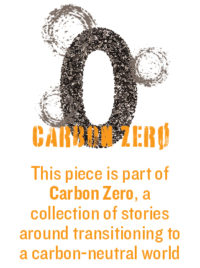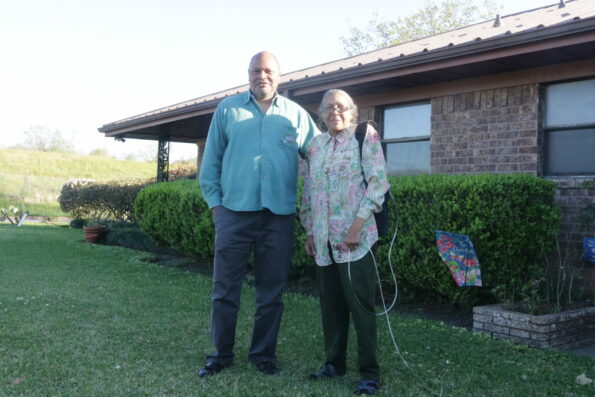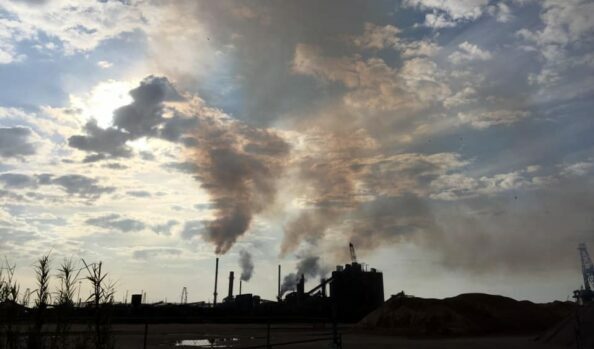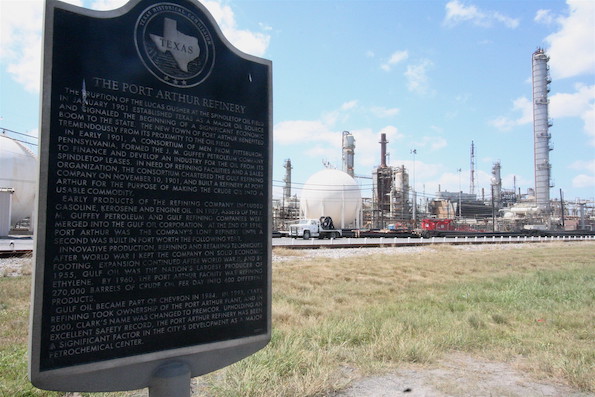July 20, 2022 —  Plopping down on a plush sofa next to his ailing mother, Dennis Mitchell sighs and shakes his head when asked about a health-care clinic near his parents’ house in Port Arthur, Texas. The clinic came about after the U.S. Environmental Protection Agency (EPA) designated the city an Environmental Justice Showcase Community in 2009, then reached an agreement for what is known as a Supplemental Environmental Project (SEP) with Valero Port Arthur Refinery that included US$1 million for the clinic’s construction. Such projects can reduce fines businesses or individuals might otherwise have to pay. The agency touts the clinic as one of the environmental justice successes it brought to Port Arthur.
Plopping down on a plush sofa next to his ailing mother, Dennis Mitchell sighs and shakes his head when asked about a health-care clinic near his parents’ house in Port Arthur, Texas. The clinic came about after the U.S. Environmental Protection Agency (EPA) designated the city an Environmental Justice Showcase Community in 2009, then reached an agreement for what is known as a Supplemental Environmental Project (SEP) with Valero Port Arthur Refinery that included US$1 million for the clinic’s construction. Such projects can reduce fines businesses or individuals might otherwise have to pay. The agency touts the clinic as one of the environmental justice successes it brought to Port Arthur.
But some, like Mitchell, see the clinic as a way to deflect attention away from the real problem: pollution and disease. “They were just trying to shut up people,” Mitchell says over the hum of his mother’s supplemental oxygen machine. “You know, calm us down, pacify us, make us forget about what’s really going on.” Mitchell’s sister died of multiple myeloma, his father died of lung cancer, and his mother, Annette, is now in the late stages of chronic obstructive pulmonary disease.

“When I came here,” says Annette Mitchell (pictured here with her son Dennis Mitchell), “African Americans could not live across the railroad tracks on the east side of town.” Photo by Nancy Averett
While no one can draw a straight line from these ailments to the petrochemical industry in Port Arthur, the Mitchells and their neighbors, aware of the high rates of cancer and other diseases in their families, believe there’s a connection. Port Arthur would have been better served, they say, if the EPA had actually reduced pollution rather than constructing a primary care clinic, which is why their fight for environmental justice continues. “Showcase what?” says John Beard Jr., when asked about the EPA’s 2009 designation. Beard runs the nonprofit Port Arthur Community Action Network (PA-CAN). “There’s no measurable nor discernible change or difference in pollution levels.”
A True Environmental Justice Moment?
When Annette Mitchell and her late husband, James Mitchell, moved to Port Arthur in 1962, Black families were clustered on the west side, where a number of oil refineries were located.
That juxtaposition was likely no accident; several peer-reviewed studies show that Black Americans breathe dirtier air than white Americans and that that disparity is due in part to past racist policies such mortgage redlining. Black residents also have had less of a political voice to fight back against the influx of polluting facilities, making it easier for industries to gain a foothold in or near communities of color.

In 2014, photographer Carol M. Highsmith took this photo of the Valero Energy Corporation’s refinery in Port Arthur as part of her America Project. Photo courtesy of GPA Photo Archive / Carol M. Highsmith / Library of Congress
“It’s tough sometimes,” says Beard about the long fight for environmental justice in his hometown. Still, he wonders if the country might be on the verge of a true environmental justice moment due to the racial reckoning ignited by the murder of George Floyd in 2020 and actions by the Biden administration.
One such action is executive order 14008, which calls for integrating environmental justice through all government agencies and established two environmental justice advisory councils. Biden also chose Michael Regan, an environmental justice advocate, to head the EPA. More recently Attorney General Merrick B. Garland created the first environmental justice office inside the Justice Department and instructed U.S. attorneys to commit staff to addressing environmental justice.
So, in the context of these changes, Beard recently took on one of Port Arthur’s petrochemical plants, the Oxbow Calcining plant. In recent years the plant has spewed about 22 million pounds (20 million metric pounds) of sulfur dioxide (SO2) annually — more than 80% of all SO2 emitted by industry in Jefferson County, where Port Arthur is located, according to nonprofit news sites Public Health Watch and the Investigative Reporting Workshop. Exposure to SO2 can contribute to respiratory tract problems. SO2 is the leading ingredient in microscopic pollution known as fine particulate matter, which can lodge deep in the lungs and has been linked to asthma, heart attacks and lung ailments such as the chronic obstructive pulmonary disease Annette Mitchell suffers from. Amendments to the 1970 Clean Air Act required plants to remove SO2 from their emissions. But established facilities like Oxbow don’t have to comply until they’ve expanded or been shown to violate air pollution standards.
“The premise was that at some point, the lifetime of these plants would be done and they’d have to rebuild with modern pollution controls,” says Tseming Yang, a law professor at Santa Clara University. “Instead you have these old plants hanging on, making incremental repairs, trying not to trigger the law.”

Amendments to the 1970 Clean Air Act required plants to remove SO2 from their emissions, but established facilities like the Oxbow Calcining plant didn’t have to comply until they expanded or were shown to violate air pollution standards. Photo by John Beard
The Texas Commission on Environmental Quality (TCEQ) could force the plant to install pollution removal technologies such as sulfur scrubbers, but it hasn’t. So Beard decided to try a different mechanism: the 1964 Civil Rights Act. In August 2021, PA-CAN filed a complaint with the EPA charging that the TCEQ was violating Title VI of the act by allowing Oxbow to pollute the air without installing modern pollution controls. Title VI allows individuals to ask the EPA to withhold funding to state, regional or local agencies that discriminate based on race, color or national origin — though so far the agency has never done so. “The [EPA’s] track record has been incredibly poor,” says Yang.
Promising Signs
Marianne Engelman Lado, a leading environmental civil rights expert, outlined the agency’s environmental justice failures in a 2019 University of Pennsylvania Journal of Law and Social Change article. She described a 2011 audit that found the EPA had failed to reach out to state agencies to raise awareness of their obligations under Title VI and did not adequately investigate or respond in a timely manner to most Title VI complaints. And the nonprofit Center for Public Integrity, which examined EPA Title VI complaints between 1996 and 2013, found that more than nine times out of 10 when “communities have turned to [the EPA] for help, the civil-rights office has either rejected or dismissed their Title VI complaints.”
Engelman Lado went from critic to insider when, last year, the Biden administration asked her to join the EPA. That hire and Regan’s are promising signs of the administration’s potential commitment to environmental justice, says Amy Laura Cahn, director of the Vermont Law School’s Environmental Justice Clinic.

A sign in Port Arthur reads, in part, “Upholding an excellent safety record, the Port Arthur refinery has been a significant factor in the city’s development as a major petrochemical center.” Photo by Roy Luck licensed under CC BY-NC-SA 4.0
Another is how the administration reacted to a 2020 EPA Office of Inspector General report that recommended the agency be more proactive about determining whether funding recipients are complying with Title VI. Cahn says the Trump administration all but ignored the inspector general’s recommendations, while the Biden administration embraced them. “Their response was markedly different,” she says, “180 degrees.” Cahn also says the number of complaints filed since Biden took office is likely to quickly outpace those filed within eight years of the Obama administration.
“I suspect it means that people are seeing a potential for the EPA to respond differently,” she says.
Several of those new complaints were filed by Nick Leonard, executive director of the Great Lakes Environmental Law Center in Detroit. These include one that takes issue with a decision by Michigan’s environmental regulatory agency to allow an automobile manufacturer to reduce emissions at a factory located in a suburban area with a majority of white residents and increase emissions — by expanding a manufacturing plant — in an overwhelmingly majority African-American urban area. Leonard said state regulators told him that they had no choice but to approve the emissions trade-off because such actions are allowed by state laws.
“And what we’ve been saying is, ‘You also have these Title VI [legal] obligations, and what are you doing to make sure that you’re meeting those?’” Leonard says. “‘And what do those even mean to you?’”
Michigan and other states may soon have to answer such questions. During a recent public call, Kurt Temple, senior advisor in the EPA’s External Civil Rights Compliance Office, said that by the end of September, the EPA plans to tell states how the agency expects them to investigate environmental discrimination claims and what they must consider, including potentially cumulative pollution impacts, before issuing a new permit. “Obviously, this is a really hot topic,” he said.
“The Ones Who Suffered the Ill Effects”
In Texas, TCEQ recently learned that insisting they’d followed all state and federal environmental laws when reissuing Oxbow’s permit might not be enough, according to Amy Dinn, attorney for Lone Star Legal Aid, which filed the complaint on PA-CAN’s behalf. The EPA told TCEQ that they had an obligation to also comply with civil rights law, she says. “That was clearly communicated, and we were pretty excited to hear that.”
Gary Rasp, TCEQ spokesman, wrote in an email that the agency was currently engaged in the informal resolution process with EPA over the complaint and would not comment further on it. Oxbow officials also declined to comment.
When EPA representatives made it clear they were going to investigate, TCEQ signaled that they wanted to meet to see if they could come to a resolution, according to Dinn. “We are hopeful that it will, at minimum, include the pollution control devices that should be on the facility,” she says. “The way that EPA has been proceeding with this so aggressively, I think they see this as potentially an easy win,” she adds.
A win that some wish would have occurred way back in 1970 when the Clean Air Act became a law and Annette and James Mitchell were relative newcomers to the area. They had two kids, owned a nice home, and could walk to church and locally owned businesses. But it wasn’t long before they were aware that they’d moved to an area that might harm their health. The fossil fuel plants emitted odors, they could see oil rainbows in puddles after rainstorms, and, decades later, friends and family started to become sick.
“When I came here, African Americans could not live across the railroad tracks on the east side of town,” says Annette, taking small gasps of air between words. “Ultimately, we were the ones who suffered the ill effects.”
Related Posts
Ensia shares solutions-focused stories free of charge through our online magazine and partner media. That means audiences around the world have ready access to stories that can — and do — help them shape a better future. If you value our work, please show your support today.
Yes, I'll support Ensia!



